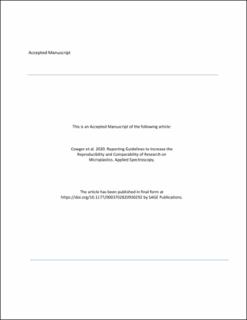Reporting Guidelines to Increase the Reproducibility and Comparability of Research on Microplastics
| dc.contributor.author | Cowger, Win | |
| dc.contributor.author | Booth, Andy M | |
| dc.contributor.author | Hamilton, Bonnie M | |
| dc.contributor.author | Thaysen, Clara | |
| dc.contributor.author | Primpke, Sebastian | |
| dc.contributor.author | Munno, Keenan | |
| dc.contributor.author | Lusher, Amy L | |
| dc.contributor.author | Dehaut, Alexandre | |
| dc.contributor.author | Vaz, Vitor P | |
| dc.contributor.author | Liboiron, Max | |
| dc.contributor.author | Devriese, Lisa I | |
| dc.contributor.author | Hermabessiere, Ludovic | |
| dc.contributor.author | Rochman, Chelsea | |
| dc.contributor.author | Athey, Samantha N | |
| dc.contributor.author | Lynch, Jennifer M | |
| dc.contributor.author | De Frond, Hannah | |
| dc.contributor.author | Gray, Andrew | |
| dc.contributor.author | Jones, Oliver AH | |
| dc.contributor.author | Brander, Susanne | |
| dc.contributor.author | Steele, Clare | |
| dc.contributor.author | Moore, Shelly | |
| dc.contributor.author | Sanchez, Alterra | |
| dc.contributor.author | Nel, Holly | |
| dc.date.accessioned | 2020-05-29T05:58:34Z | |
| dc.date.available | 2020-05-29T05:58:34Z | |
| dc.date.created | 2020-05-06T13:56:17Z | |
| dc.date.issued | 2020-05-12 | |
| dc.identifier.citation | Applied Spectroscopy. 2020, . | en_US |
| dc.identifier.issn | 0003-7028 | |
| dc.identifier.uri | https://hdl.handle.net/11250/2655947 | |
| dc.description.abstract | The ubiquitous pollution of the environment with microplastics - a diverse suite of contaminants - is of growing concern for science and currently receives considerable public, political, and academic attention. The potential impact of microplastics in the environment has prompted a great deal of research in recent years. Many diverse methods have been developed to answer different questions about microplastic pollution, from sources, transport, and fate in the environment, and about effects on humans and wildlife. These methods are often insufficiently described, making studies neither comparable nor reproducible. The proliferation of new microplastic investigations and cross-study syntheses to answer larger scale questions are hampered. We - a diverse group of 23 researchers - think these issues can begin to be overcome through the adoption of a set of reporting guidelines. This collaboration was created using an open science framework that we detail for future use. Here, we suggest harmonized reporting guidelines for microplastic studies in environmental and laboratory settings through all steps of a typical study, including best practices for reporting materials, quality assurance / quality control, data, field sampling, sample preparation, microplastic identification, microplastic categorization, microplastic quantification, and considerations for toxicology studies. We developed three easy to use documents - a detailed document, a checklist, and a mind map - that can be used to quickly reference the reporting guidelines. It is our intention that these reporting guidelines support the annotation, dissemination, interpretation, reviewing, and synthesis of microplastic research. Through open access licensing (CC BY 4.0), these documents aim to increase the validity, reproducibility, and comparability of studies in this field for the benefit of the global community. | en_US |
| dc.language.iso | eng | en_US |
| dc.publisher | Sage Journals | en_US |
| dc.subject | Harmonization | en_US |
| dc.subject | standardization | en_US |
| dc.subject | plastic | en_US |
| dc.subject | microplastic | en_US |
| dc.subject | metadata | en_US |
| dc.subject | reproducibility | en_US |
| dc.subject | open science | en_US |
| dc.subject | methods | en_US |
| dc.subject | reporting guidelines | en_US |
| dc.subject | comparability | en_US |
| dc.title | Reporting Guidelines to Increase the Reproducibility and Comparability of Research on Microplastics | en_US |
| dc.type | Journal article | en_US |
| dc.type | Peer reviewed | en_US |
| dc.description.version | acceptedVersion | en_US |
| dc.source.pagenumber | 31 | en_US |
| dc.source.journal | Applied Spectroscopy | en_US |
| dc.identifier.doi | 10.1177/0003702820930292 | |
| dc.identifier.cristin | 1809672 | |
| dc.relation.project | Norges forskningsråd: 257479 | en_US |
| dc.relation.project | Norges forskningsråd: 268404 | en_US |
| cristin.ispublished | false | |
| cristin.fulltext | postprint | |
| cristin.qualitycode | 1 |
Tilhørende fil(er)
Denne innførselen finnes i følgende samling(er)
-
Publikasjoner fra CRIStin - SINTEF Ocean [1369]
-
SINTEF Ocean [1443]
